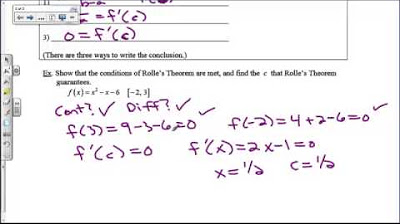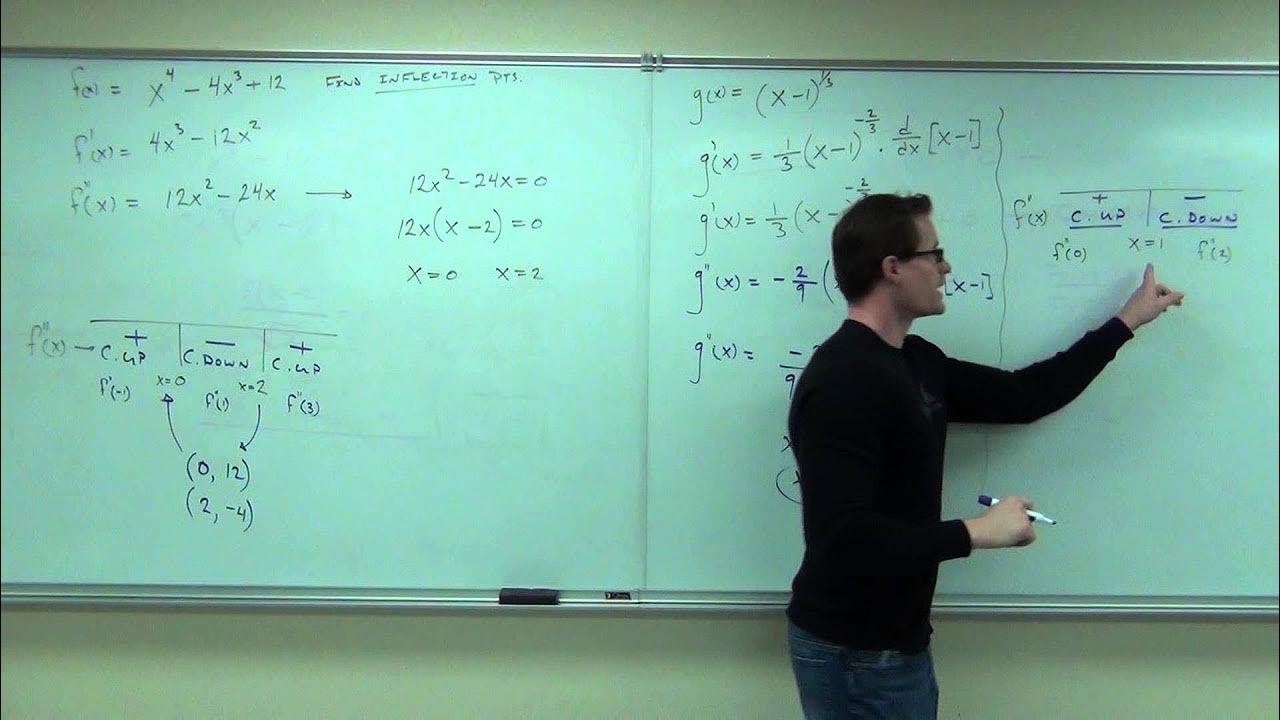Lec 14 | MIT 18.01 Single Variable Calculus, Fall 2007
TLDRThis lecture delves into the intricacies of Newton's method, emphasizing its remarkable accuracy in finding roots of a function. The professor illustrates the iterative process and discusses the potential pitfalls, such as starting far from the target root or encountering points where the derivative is zero or undefined. The session transitions into an exploration of the Mean Value Theorem (MVT), providing both colloquial and mathematical explanations, and highlighting its significance in understanding the behavior of functions. The MVT is shown to be a fundamental link between the average speed and the instantaneous speed of a function, leading to insights about the function's increase, decrease, or constancy. The lecture concludes with applications of the MVT to prove inequalities, showcasing its utility in establishing relationships between functions.
Takeaways
- 📚 The lecture is a continuation of a previous session, focusing on Newton's method and its accuracy in finding roots of a function.
- 🔍 Newton's method involves taking an initial guess, drawing a tangent to the curve at that point, and using the tangent to refine the guess iteratively.
- 📉 The accuracy of Newton's method is impressive, doubling the number of correct digits with each iteration under the right conditions.
- 📈 The method requires that the first derivative of the function not be too small and the second derivative not be too large near the root.
- 📝 The initial guess (x0) must be close to the actual root; otherwise, the method may converge to the wrong root or fail.
- ⚠️ There are pitfalls with Newton's method, such as starting too far from the root or encountering a point where the derivative is zero, which can lead to failure.
- 🌟 The Mean Value Theorem (MVT) is introduced as a theoretical concept that will have significant implications for the rest of the course, especially in integration.
- 🔢 The MVT states that for a function that is continuous on a closed interval and differentiable on an open interval, there exists at least one point c where the average rate of change equals the instantaneous rate of change.
- 📉 The theorem is proved using a geometric argument involving secant lines and tangent lines, showing that there must be a point where the tangent line has the same slope as the secant line connecting two endpoints.
- 📘 The hypotheses of the MVT are that the function must be differentiable between points a and b and continuous at all points including the endpoints.
- 📊 The MVT is used to establish properties of functions, such as if the derivative is positive, the function is increasing; if the derivative is negative, the function is decreasing; and if the derivative is zero, the function is constant.
Q & A
What is the main topic discussed in the provided script?
-The main topic discussed in the script is Newton's method, its accuracy, and the Mean Value Theorem (MVT), along with their applications in calculus.
What is Newton's method and why is its accuracy important?
-Newton's method is an iterative numerical technique used to find the roots of a real-valued function. Its accuracy is important because it determines how close the method gets to the actual root with each iteration, and it helps in quickly achieving high precision in numerical solutions.
How does Newton's method work in a practical sense?
-Newton's method works by taking an initial guess for the root, drawing a tangent to the curve at that point, and using the tangent to find a better approximation. This process is repeated, with each new approximation being used to draw a new tangent, until the desired level of accuracy is reached.
What are the conditions for Newton's method to work effectively?
-For Newton's method to work effectively, the derivative of the function (f') should not be too small, and the second derivative (f'') should not be too large. Additionally, the initial guess (x0) should be reasonably close to the actual root.
What is the Mean Value Theorem, and what does it imply?
-The Mean Value Theorem (MVT) states that if a function is continuous on the closed interval [a, b] and differentiable on the open interval (a, b), then there exists at least one point c in (a, b) where the derivative of the function at c is equal to the average rate of change of the function over the interval [a, b]. It implies that the instantaneous speed at some point during a journey is equal to the average speed over that journey.
What are the implications of the Mean Value Theorem for the behavior of a function?
-The Mean Value Theorem implies that if the derivative of a function (f') is positive, then the function is increasing. If f' is negative, the function is decreasing. And if f' equals zero, the function is constant over the interval.
How is the Mean Value Theorem used to prove inequalities involving exponential functions?
-The Mean Value Theorem can be used to prove inequalities by considering a new function that represents the difference between the two sides of the inequality. By showing that this new function is increasing and starts at zero, one can prove that the inequality holds for all values in the specified interval.
What are some potential issues that can arise when using Newton's method?
-Some potential issues with Newton's method include the possibility of converging to the wrong root if the initial guess is too far away, encountering a point where the derivative is zero (causing division by zero), and getting stuck in a cycle where the approximation oscillates between two values without converging to a root.
How does the script illustrate the concept of the Mean Value Theorem geometrically?
-The script illustrates the Mean Value Theorem geometrically by showing a graph of a function and constructing a tangent line with the same slope as the secant line between two points on the graph. The point of tangency is used to demonstrate that the instantaneous rate of change (derivative) at some point within the interval is equal to the average rate of change over that interval.
What is the relationship between the Mean Value Theorem and linear approximation?
-The Mean Value Theorem provides a rigorous justification for the linear approximation of a function. While linear approximation gives an estimate of the change in a function based on its derivative at a single point, the Mean Value Theorem guarantees that there exists some point in the interval where the actual change in the function is exactly equal to the derivative at that point times the change in the independent variable.
Outlines
📚 Introduction to Newton's Method and MIT OpenCourseWare
The professor begins by acknowledging the support of the audience which enables MIT OpenCourseWare to provide educational resources for free. He then dives into a review of Newton's method, emphasizing its importance for finding the roots of a function. The method is explained through an iterative process that involves taking guesses and drawing tangent lines to approximate the root. The professor also introduces the formula for the next guess and stresses the importance of understanding the process for its practical applications.
🔍 Analyzing the Accuracy and Error of Newton's Method
This section focuses on the qualitative error analysis of Newton's method. The professor illustrates how the distance between the guessed value (x1) and the actual root (x), referred to as Error 1, can be measured. He then explains how each subsequent guess (x2, x3, etc.) brings the approximation closer to the actual root, with the error approximately halving with each iteration. The professor also discusses the conditions under which Newton's method works best, such as the function's first derivative not being too small and the second derivative not being too large, and the initial guess being close to the actual root.
⚠️ Potential Pitfalls of Newton's Method
The professor discusses the potential failures of Newton's method. He explains that starting too far from the actual root can lead to finding the wrong root or not converging at all. He also highlights the issue of having a horizontal tangent line when the first derivative is zero, which can cause the method to fail since it involves division by the first derivative. Additionally, he describes a scenario where the method can get stuck in a cycle, oscillating between two points without making progress towards the root.
📈 Transitioning to Theoretical Concepts: Mean Value Theorem (MVT)
The professor shifts the discussion towards a more theoretical concept, the Mean Value Theorem (MVT), which will be foundational for the upcoming topics on integration. He introduces MVT with an analogy of traveling from Boston to LA, explaining that at some point during the journey, the instantaneous speed must have equaled the average speed. The professor then formally states the theorem, including its hypotheses, and provides a geometric intuitive argument for its proof, involving secant and tangent lines.
📘 Proof and Implications of the Mean Value Theorem
The professor provides a detailed proof of the Mean Value Theorem, using a graphical approach to demonstrate how a tangent line with a specific slope can be constructed. He emphasizes the importance of understanding the hypotheses behind the theorem and provides an example to show that the theorem's proof does not hold if the derivative does not exist at some point within the interval. The professor then outlines the consequences of the theorem, which include the relationship between the derivative's sign and the function's monotonicity, and the fact that a derivative of zero implies a constant function.
📊 Distinguishing Between Mean Value Theorem and Linear Approximation
The professor clarifies the difference between the Mean Value Theorem and linear approximation. While linear approximation provides an estimate of the change in a function based on its derivative at a single point, the Mean Value Theorem asserts that the average rate of change over an interval is exactly equal to the instantaneous rate of change at some point within that interval. The discussion highlights that the theorem provides a more precise relationship between the change in the function and its derivative.
📚 Applications of the Mean Value Theorem to Inequalities
The professor demonstrates practical applications of the Mean Value Theorem, particularly in proving inequalities. He uses the theorem to show that e^x is greater than 1 + x for x > 0, by considering the function e^x - (1 + x) and proving it is increasing. He then extends this principle to prove further inequalities, such as e^x being greater than 1 + x + (x^2 / 2) for x > 0, by introducing additional functions and applying the same reasoning. The professor illustrates how these principles can be iteratively applied to derive more complex inequalities.
Mindmap
Keywords
💡Newton's Method
💡Tangent Line
💡Iteration
💡Error Analysis
💡Derivative
💡Mean Value Theorem (MVT)
💡Continuous Function
💡Differentiable Function
💡Secant Line
💡Inequality
Highlights
Introduction to Newton's method and its accuracy in finding roots of a function.
Explanation of the iterative process of Newton's method to refine guesses for the root.
Visualization of Newton's method through tangent lines to approximate the root.
Formula for generating the next guess in Newton's method.
Qualitative error analysis of Newton's method to understand its convergence.
The quadratic nature of the error reduction in Newton's method.
Conditions for Newton's method to work effectively: non-small first derivative and non-large second derivative.
Potential failure of Newton's method if the initial guess is too far from the actual root.
The importance of the first derivative not being zero to avoid undefined values in Newton's method.
Illustration of a cycle in Newton's method where the guess oscillates between two points without converging.
Transition to the Mean Value Theorem (MVT) and its significance in calculus.
Intuitive explanation of the MVT using the analogy of average speed.
Mathematical statement and hypotheses of the MVT.
Geometric proof of the MVT using secant and tangent lines.
Importance of differentiability and continuity in the application of the MVT.
Consequences of the MVT relating to the behavior of functions and their derivatives.
Proof that if a function's derivative is positive, the function is increasing.
Application of the MVT to prove inequalities involving exponential functions.
Demonstration of how the MVT can be used to establish bounds on functions.
Discussion on the difference between the MVT and linear approximation.
Illustration of how the MVT guarantees that the average speed is between the maximum and minimum speeds.
Explanation of how the MVT is used in practice to understand the relationship between functions and their derivatives.
Transcripts
Browse More Related Video

Mean Value Theorem and Rolle's Theorem

The MEAN Value Theorem is Actually Very Nice

Mean value theorem | Existence theorems | AP Calculus AB | Khan Academy

Using the Mean Value Theorem with a Table of Values

Math 11 - Sections 1.3-1.4

Calculus 1 Lecture 3.4: The Second Derivative Test for Concavity of Functions
5.0 / 5 (0 votes)
Thanks for rating: